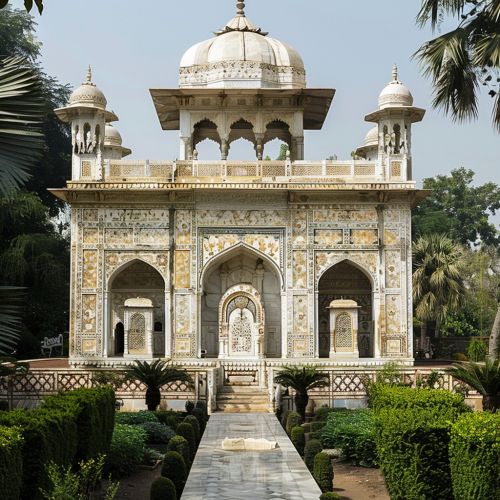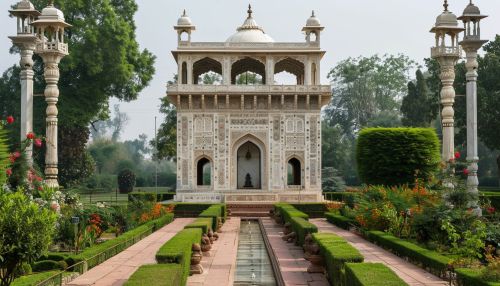Jahangir: Difference between revisions
(Created page with "== Early Life and Background == Nur-ud-din Muhammad Salim, better known by his imperial name Jahangir, was born on 31 August 1569 in Fatehpur Sikri, India. He was the fourth Mughal Emperor, ruling from 1605 until his death in 1627. Jahangir was the eldest surviving son of Emperor Akbar and his Rajput wife, Mariam-uz-Zamani. His upbringing was marked by a blend of Persian and Indian influences, reflecting the diverse cultural milieu of the Mughal court. == Ascen...") |
No edit summary |
||
| Line 27: | Line 27: | ||
While Jahangir is not as renowned for architectural achievements as his predecessors, his reign saw the construction of several notable structures. The [[Tomb of Itimad-ud-Daulah]] in Agra, often referred to as a "jewel box" due to its exquisite marble inlay work, was commissioned by his wife, Nur Jahan, in memory of her father. This tomb is considered a precursor to the [[Taj Mahal]]. | While Jahangir is not as renowned for architectural achievements as his predecessors, his reign saw the construction of several notable structures. The [[Tomb of Itimad-ud-Daulah]] in Agra, often referred to as a "jewel box" due to its exquisite marble inlay work, was commissioned by his wife, Nur Jahan, in memory of her father. This tomb is considered a precursor to the [[Taj Mahal]]. | ||
[[Image:Detail-92237.jpg|thumb|center|The Tomb of Itimad-ud-Daulah, a white marble mausoleum with intricate inlay work, set in a lush garden.|class=only_on_mobile]] | |||
[[Image:Detail-92238.jpg|thumb|center|The Tomb of Itimad-ud-Daulah, a white marble mausoleum with intricate inlay work, set in a lush garden.|class=only_on_desktop]] | |||
=== Literature and Memoirs === | === Literature and Memoirs === | ||
Latest revision as of 14:01, 17 June 2024
Early Life and Background
Nur-ud-din Muhammad Salim, better known by his imperial name Jahangir, was born on 31 August 1569 in Fatehpur Sikri, India. He was the fourth Mughal Emperor, ruling from 1605 until his death in 1627. Jahangir was the eldest surviving son of Emperor Akbar and his Rajput wife, Mariam-uz-Zamani. His upbringing was marked by a blend of Persian and Indian influences, reflecting the diverse cultural milieu of the Mughal court.
Ascension to the Throne
Jahangir's path to the throne was not without its challenges. His early life was marked by a strained relationship with his father, Akbar, due to his rebellious nature and his involvement in court intrigues. Despite these tensions, Jahangir ascended to the throne in 1605 following Akbar's death. His accession was marked by a grand coronation ceremony in Agra, where he adopted the title "Nur-ud-din Muhammad Jahangir Padshah Ghazi."
Reign and Administration
Jahangir's reign is noted for its relative stability and the continuation of the policies initiated by his father. He maintained a centralized administrative structure, with a strong emphasis on justice and governance. Jahangir's administration was characterized by a system of mansabdari, a military and administrative framework that categorized officials based on their rank and responsibilities.
Justice and Legal Reforms
One of Jahangir's most notable contributions was his emphasis on justice. He established the "Chain of Justice," a golden chain with bells that extended from his palace to a post on the street, allowing any aggrieved person to seek the emperor's attention directly. This symbolic gesture underscored Jahangir's commitment to accessible and impartial justice.
Economic Policies
Jahangir's economic policies were aimed at ensuring the prosperity of his empire. He continued Akbar's policy of land revenue reforms, which involved the assessment and collection of taxes based on crop yields. Jahangir also promoted trade and commerce, fostering relations with European traders, particularly the British East India Company, which established its first factory in Surat during his reign.
Cultural Contributions
Jahangir was a patron of the arts, and his reign is often regarded as a golden age of Mughal culture. He had a keen interest in painting, and his court became a hub for artists and craftsmen. The Mughal school of painting flourished under his patronage, characterized by its intricate detail, vibrant colors, and realistic portrayal of subjects.
Architecture
While Jahangir is not as renowned for architectural achievements as his predecessors, his reign saw the construction of several notable structures. The Tomb of Itimad-ud-Daulah in Agra, often referred to as a "jewel box" due to its exquisite marble inlay work, was commissioned by his wife, Nur Jahan, in memory of her father. This tomb is considered a precursor to the Taj Mahal.


Literature and Memoirs
Jahangir was also a prolific writer, and his memoirs, the Tuzuk-i-Jahangiri, provide a detailed account of his reign. These memoirs offer valuable insights into the political, social, and cultural life of the Mughal Empire. Jahangir's keen observations and descriptive style make his memoirs an important historical source.
Personal Life
Jahangir's personal life was marked by his relationships with his wives and his struggle with addiction. His marriage to Nur Jahan, a Persian noblewoman, had a significant impact on his reign. Nur Jahan wielded considerable influence over the emperor and the administration, effectively becoming the power behind the throne. Jahangir's dependency on alcohol and opium, however, affected his health and governance.
Nur Jahan's Influence
Nur Jahan's influence on Jahangir and the Mughal court was profound. She was an astute politician and a patron of the arts. Her ability to issue imperial orders and coins in her name was unprecedented for a Mughal empress. Nur Jahan's administrative acumen and diplomatic skills were instrumental in maintaining the stability of Jahangir's reign.
Foreign Relations
Jahangir's reign saw significant interactions with foreign powers. His court was visited by several European envoys, including Sir Thomas Roe, the ambassador of King James I of England. These interactions facilitated trade and cultural exchanges, contributing to the cosmopolitan nature of the Mughal court.
Relations with the Safavid Empire
Jahangir maintained cordial relations with the Safavid Empire of Persia. Diplomatic missions and exchanges of gifts were common, reflecting the mutual respect between the two empires. Jahangir's Persian heritage through his mother also played a role in fostering these relations.
Conflicts and Military Campaigns
Despite his focus on administration and culture, Jahangir's reign was not devoid of military conflicts. He faced rebellions from regional governors and challenges from the Deccan Sultanates. Jahangir's military campaigns were aimed at consolidating Mughal control over these regions, although his success was limited compared to his predecessors.
Legacy
Jahangir's legacy is multifaceted, encompassing his contributions to administration, culture, and foreign relations. His reign is often seen as a period of consolidation and cultural flourishing. Jahangir's emphasis on justice, his patronage of the arts, and his diplomatic engagements left an indelible mark on the Mughal Empire.
Succession
Jahangir's death in 1627 led to a brief succession struggle, ultimately resulting in the accession of his son, Shah Jahan. Shah Jahan's reign would later be marked by significant architectural achievements, including the construction of the Taj Mahal, furthering the cultural legacy of the Mughal dynasty.
